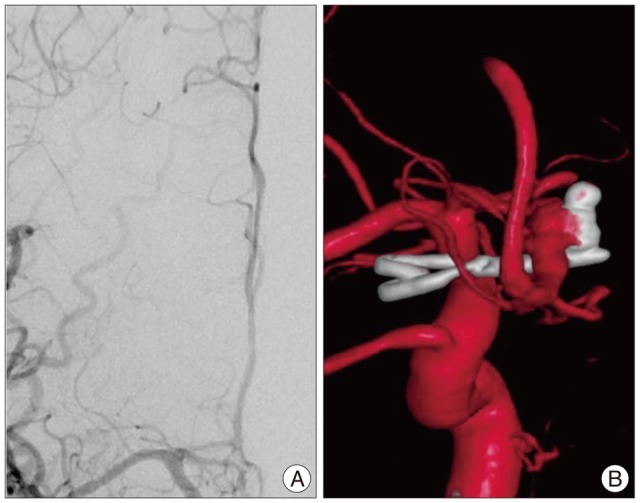J Korean Neurosurg Soc.
2013 Apr;53(4):241-244. 10.3340/jkns.2013.53.4.241.
Temporary Semi-Jailing Technique for Coil Embolization of Wide-Neck Aneurysm with Small Caliber Parent Artery Following Incomplete Clipping
- Affiliations
-
- 1Department of Radiology, Chung-Ang University College of Medicine, Seoul, Korea. flightdr61@cau.ac.kr
- 2Department of Neurosurgery, Chung-Ang University College of Medicine, Seoul, Korea.
- KMID: 1426211
- DOI: http://doi.org/10.3340/jkns.2013.53.4.241
Abstract
- The authors describe the use of a self-expandable stent in a temporary deployment for treatment of a very wide-neck A1 segment of anterior cerebral artery (ACA) aneurysm following incomplete clipping. A 39-year-old hypertensive man presenting with seizure-like movement underwent computed tomography, which showed acute subarachnoid hemorrhage and an A1 segment of ACA aneurysm with superior and inferior projection. He underwent surgical clipping of the aneurysm, but superior and posterior portion of wide-neck aneurysm remained. We decided to treat the remnant aneurysm using an endovascular modality. After selection of the aneurysm, coil packing was performed assisted by the temporary semi-jailing technique. The Enterprise stent (Cordis Neurovascular, Miami, FL, USA) was deployed and recaptured repeatedly for angiography to ensure safety of the small caliber parent artery. Successful semi-deployment and recapture of the stent allowed subtotal coil occlusion of the aneurysm with good anatomic and clinical results. No complications were encountered. The stent could be recaptured up to the point where the proximal end of the stent marker was aligned with distal marker band of the microcatheter, approximately 70% of the stent length. The temporary semi-jailing technique is feasible for wide-neck aneurysm with small caliber parent artery.
MeSH Terms
Figure
Cited by 1 articles
-
Semi-Jailing Technique Using a Neuroform3 Stent for Coiling of Wide-Necked Intracranial Aneurysms
Jun Kyeung Ko, Won Ho Cho, Seung Heon Cha, Chang Hwa Choi, Sang Weon Lee, Tae Hong Lee
J Korean Neurosurg Soc. 2017;60(2):146-154. doi: 10.3340/jkns.2016.0607.002.
Reference
-
1. Bendok BR, Ali MJ, Malisch TW, Russell EJ, Batjer HH. Coiling of cerebral aneurysm remnants after clipping. Neurosurgery. 2002; 51:693–697. discussion 697-698. PMID: 12188947.
Article2. Biondi A, Janardhan V, Katz JM, Salvaggio K, Riina HA, Gobin YP. Neuroform stent-assisted coil embolization of wide-neck intracranial aneurysms : strategies in stent deployment and midterm follow-up. Neurosurgery. 2007; 61:460–468. discussion 468-469. PMID: 17881956.3. de Paula Lucas C, Piotin M, Spelle L, Moret J. Stent-jack technique in stent-assisted coiling of wide-neck aneurysms. Neurosurgery. 2008; 62:ONS414–ONS416. discussion ONS416-ONS417. PMID: 18596523.4. Debrun GM, Aletich VA, Kehrli P, Misra M, Ausman JI, Charbel F. Selection of cerebral aneurysms for treatment using Guglielmi detachable coils : the preliminary University of Illinois at Chicago experience. Neurosurgery. 1998; 43:1281–1295. discussion 1296-1297. PMID: 9848841.
Article5. Drake CG, Friedman AH, Peerless SJ. Failed aneurysm surgery. Reoperation in 115 cases. J Neurosurg. 1984; 61:848–856. PMID: 6491730.6. Drake CG, Vanderlinden RG. The late consequences of incomplete surgical treatment of cerebral aneurysms. J Neurosurg. 1967; 27:226–238. PMID: 6047996.
Article7. Feuerberg I, Lindquist C, Lindqvist M, Steiner L. Natural history of postoperative aneurysm rests. J Neurosurg. 1987; 66:30–34. PMID: 3783256.
Article8. Giannotta SL, Litofsky NS. Reoperative management of intracranial aneurysms. J Neurosurg. 1995; 83:387–393. PMID: 7666212.
Article9. Hong B, Patel NV, Gounis MJ, DeLeo MJ 3rd, Linfante I, Wojak JC, et al. Semi-jailing technique for coil embolization of complex, wide-necked intracranial aneurysms. Neurosurgery. 2009; 65:1131–1138. discussion 1138-1139. PMID: 19934972.
Article10. Kai Y, Hamada J, Morioka M, Yano S, Mizuno T, Kuratsu J. Double microcatheter technique for endovascular coiling of wide-neck aneurysms using a new guiding device for the transcarotid approach : technical note. Neuroradiology. 2005; 47:73–77. PMID: 15647950.
Article11. Lin T, Fox AJ, Drake CG. Regrowth of aneurysm sacs from residual neck following aneurysm clipping. J Neurosurg. 1989; 70:556–560. PMID: 2926496.
Article12. Lopes DK, Wells K. Stent remodeling technique for coiling of ruptured wide-neck cerebral aneurysms : case report. Neurosurgery. 2009; 65:E1007–E1008. discussion E1008. PMID: 19834390.13. Mericle RA, Wakhloo AK, Rodriguez R, Guterman LR, Hopkins LN. Temporary balloon protection as an adjunct to endosaccular coiling of wide-necked cerebral aneurysms : technical note. Neurosurgery. 1997; 41:975–978. PMID: 9316065.
Article14. Piotin M, Blanc R, Spelle L, Mounayer C, Piantino R, Schmidt PJ, et al. Stent-assisted coiling of intracranial aneurysms : clinical and angiographic results in 216 consecutive aneurysms. Stroke. 2010; 41:110–115. PMID: 19959540.15. Rabinstein AA, Nichols DA. Endovascular coil embolization of cerebral aneurysm remnants after incomplete surgical obliteration. Stroke. 2002; 33:1809–1815. PMID: 12105358.
Article16. Thornton J, Bashir Q, Aletich VA, Debrun GM, Ausman JI, Charbel FT. What percentage of surgically clipped intracranial aneurysms have residual necks? Neurosurgery. 2000; 46:1294–1298. discussion 1298-1300. PMID: 10834634.
Article17. Thornton J, Dovey Z, Alazzaz A, Misra M, Aletich VA, Debrun GM, et al. Surgery following endovascular coiling of intracranial aneurysms. Surg Neurol. 2000; 54:352–360. PMID: 11165609.
Article
- Full Text Links
- Actions
-
Cited
- CITED
-
- Close
- Share
- Similar articles
-
- Temporary Semi-Jailing Technique Avoiding Inevitable Antiplatelet Medication for Coil Embolization of Wide-necked Cerebral Aneurysms
- Parent Artery Complex Coil Protection for Side-Branched Wide-Neck Aneurysms
- Microcatheter-assisted Coil Embolization of Distal Vertebral Artery Wide-Necked Aneurysm: A Case Report
- Surgical Removal of Coil and Clipping of Aneurysm after Failure of Intraaneurysmal Coil Embolization: Case Report
- Intra-aneurysmal Pressure Changes according to Clippings on the Parent Artery and Aneurysm in Experimental Model of Rabbits: a Preliminary Study





